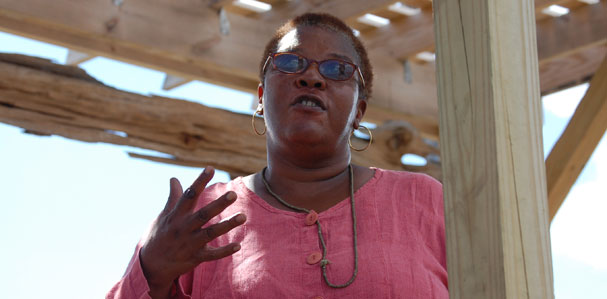“With the support of good people and the resilience of brave people, it seems like anything can be accomplished. Sustain the Nine.”
— the late Pamela Dashiell, climate justice leader based in New Orleans’ Lower Ninth Ward

With the tenth anniversary of Hurricane Katrina around the corner — August 29th — I’ve been thinking about justice. What do environmental justice, and climate justice, mean to me? Who are my environmental justice and climate justice (s)heroes?
When I think about justice, I think about communities living on the front lines. People living on the Gulf Coast from New Orleans to Miami. People living near industrial facilities — mines, refineries, and power plants. Too many of these people are sick. They are physically ill with diseases like asthma, COPD, cancer, reproductive and neurological challenges. As weather patterns drastically change, these sick people are also bearing the brunt of climate disasters.
From those suffering from the recent flooding in Houston, to the farm workers in California’s drought-hit Central Valley, to the families still living with the horror of Hurricanes Katrina and Rita — these people face injustice every day. They live in the shadows of large industry and are excluded from political debates.
These are people that are directly impacted by the horrors of corporate greed and climate change. On top of the life challenges that everyone faces — finding a decent place to live and putting food on the table — they also carry the burden of possibly having to evacuate their home and/or a higher incidence of suffering from long-term disease. And they have fewer resources for support.
The odds are against these communities. However, in the wake of disaster and sickness, some leaders rise above the odds.
When I think of climate justice (s)heroes, I think first of a powerful ally I was lucky enough to work with, whom we’ve now sadly lost: Pam Dashiell. Just after Hurricane Katrina, Pam returned to New Orleans and fought for the right to bring people home — to have people rebuild in the Lower Ninth Ward, one of the city’s hardest hit areas, even though many in power wanted to condemn it.
Pam founded the Lower 9th Ward Center for Sustainable Engagement and Development (CSED), which helped returning residents get building materials and trained them to construct more sustainable and energy-efficient houses. Pam’s tenacity and influence grew quickly. She was involved in White House meetings about rebuilding the Lower Ninth Ward and collaborated with Brad Pitt on the Make it Right project. Pitt raised funds to build 100 green certified homes in the Lower Ninth Ward with regular community input.
I met Pam through her work with the Louisiana Bucket Brigade. Pam had an uncanny awareness about the racial and environmental injustices in the Ninth Ward and had put her whole self into changing them.
Pam passed in December 2009 at age 61. Pam was one person that had a strong impact on her community. In the midst of devastation, this woman rose above the destruction and the politics and continued the work for justice.
Ahead of the tenth anniversary of Hurricane Katrina, I think about climate justice leaders, like Pam, that I have had the opportunity to meet and stand beside in their struggles — our struggles. Despite their own personal suffering, many of these leaders were able to rise to the occasion, relentlessly driving forward in pursuit of something bigger. Knowing their community deserved better.
They were ordinary people, that were able to do something extraordinary. When reflecting, it is in these moments, often filled with sadness, anger, rage and fear, that I remember that to stand in solidarity means to stand strong with climate justice communities. In reflecting on lessons from leaders, like Pam, it reminds me that I have a duty and responsibility to support communities in need.
These communities are on the front lines of climate injustice, and they should be at the forefront of the environmental and social justice movements. When we are able to support children to breathe freely, find renewable jobs for low income communities and to stop industrial waste from being released into the air, land and water, then we have started to do our job as a movement.
This month, climate justice is the focus of Change the Course, a project that crowdsources a vision of a just and climate-stable 2050 and brainstorms strategies to get there. Since last fall, we’ve been listening to the best ideas for how we win on climate. The emerging vision is one in which communities on the front lines lead the movements that fight for an equitable and sustainable future. We’d love for you to be part of Change the Course. Add your vision!
Banner image: FEMA
